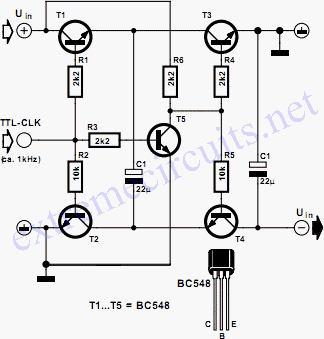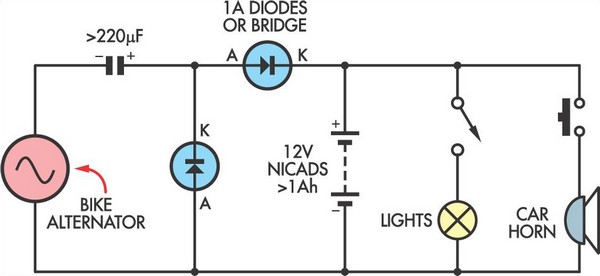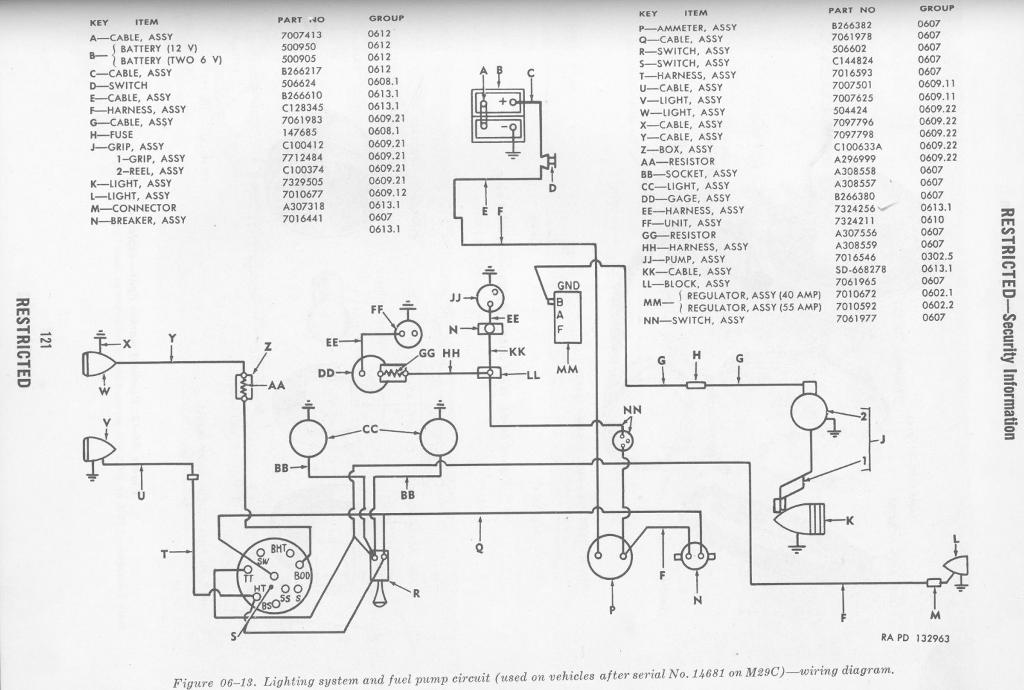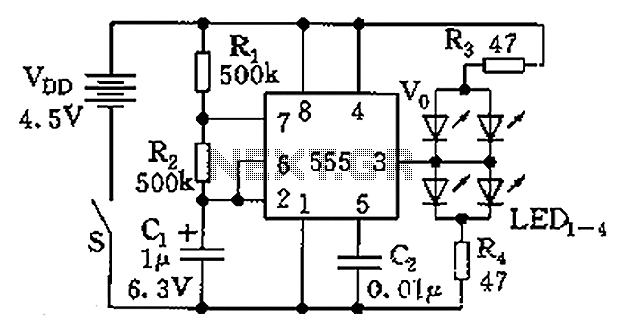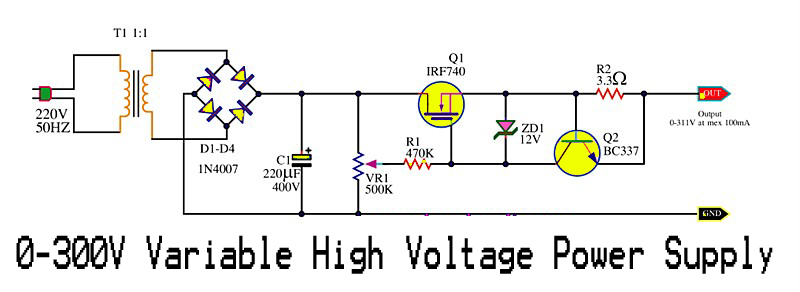
6V to 220V inverter schematic Schematic Diagram
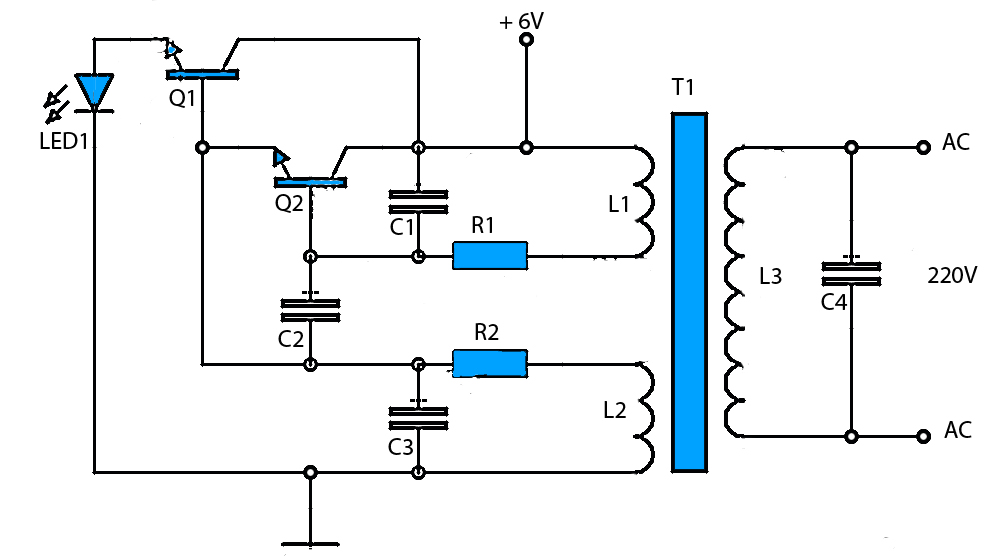
The circuit schematic presented is a voltage inverter circuit that converts a 6-volt DC input into a 220-volt AC output. It is designed to deliver a maximum output power of 30 watts and operates with a low input current. The input voltage is applied to transistor Q2, which regulates the voltage at its collector before it is transferred to the transformer. The inductor L1 connects to the base of the transistor, while the emitter is combined with the minimum voltage supplied by inductor L2. Additionally, LED1 serves as an indicator to show whether the inverter is functioning, particularly in relation to transistor Q2.
The voltage inverter circuit operates by utilizing a transistor as a switch to control the flow of current through the transformer. The 6-volt DC input is fed into the base of transistor Q2, which is configured in a common-emitter arrangement. When the base voltage exceeds the threshold, Q2 conducts, allowing current to flow from the collector to the emitter. This action induces a magnetic field in the transformer, which in turn generates a higher voltage at the secondary winding, producing the desired 220-volt AC output.
Inductor L1 plays a crucial role in the feedback mechanism, providing necessary base current to maintain the transistor's operation. The design ensures that the transistor operates in a switching mode, allowing for efficient energy transfer and minimizing heat generation. Inductor L2 is used to stabilize the voltage supplied to the emitter, ensuring consistent operation of the circuit under varying load conditions.
The inclusion of LED1 is an essential feature for user feedback, as it visually indicates the operational status of the inverter. When the circuit is active and Q2 is conducting, LED1 illuminates, confirming that the inverter is functioning correctly. This feature is particularly useful for troubleshooting and monitoring the inverter's performance.
Overall, this voltage inverter circuit is compact and efficient, suitable for applications requiring a modest power output while converting low-voltage DC to high-voltage AC. It is important to ensure that all components are rated appropriately for the expected voltage and current levels to maintain reliability and safety during operation.Circuit schematic above is one of the voltage inverter circuit, starting from 6-Volt input on the DC current into 220-volt AC output. For maximum output power up to 30W only, and is also very small voltage current. Input voltage plus the entrance on the transistor Q2 to provide the voltage at the collector and then go on Circumference transformer
L1 and enter the base. Emitter will be merged ddengan voltage supplied L2 min. And LED 1 is useful as an indicator of whether or not an inverter works especially on the transistor Q2. 🔗 External reference
The voltage inverter circuit operates by utilizing a transistor as a switch to control the flow of current through the transformer. The 6-volt DC input is fed into the base of transistor Q2, which is configured in a common-emitter arrangement. When the base voltage exceeds the threshold, Q2 conducts, allowing current to flow from the collector to the emitter. This action induces a magnetic field in the transformer, which in turn generates a higher voltage at the secondary winding, producing the desired 220-volt AC output.
Inductor L1 plays a crucial role in the feedback mechanism, providing necessary base current to maintain the transistor's operation. The design ensures that the transistor operates in a switching mode, allowing for efficient energy transfer and minimizing heat generation. Inductor L2 is used to stabilize the voltage supplied to the emitter, ensuring consistent operation of the circuit under varying load conditions.
The inclusion of LED1 is an essential feature for user feedback, as it visually indicates the operational status of the inverter. When the circuit is active and Q2 is conducting, LED1 illuminates, confirming that the inverter is functioning correctly. This feature is particularly useful for troubleshooting and monitoring the inverter's performance.
Overall, this voltage inverter circuit is compact and efficient, suitable for applications requiring a modest power output while converting low-voltage DC to high-voltage AC. It is important to ensure that all components are rated appropriately for the expected voltage and current levels to maintain reliability and safety during operation.Circuit schematic above is one of the voltage inverter circuit, starting from 6-Volt input on the DC current into 220-volt AC output. For maximum output power up to 30W only, and is also very small voltage current. Input voltage plus the entrance on the transistor Q2 to provide the voltage at the collector and then go on Circumference transformer
L1 and enter the base. Emitter will be merged ddengan voltage supplied L2 min. And LED 1 is useful as an indicator of whether or not an inverter works especially on the transistor Q2. 🔗 External reference
